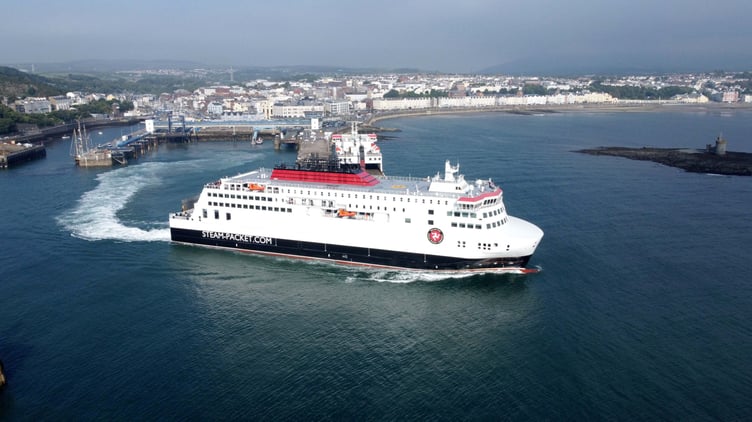Shipping, like many industries, is having to make significant changes to reduce its environmental impact.
New ambitions set by the International Maritime Organisation in July this year requires for greenhouse gas emissions to be net zero by or around 2050.
The Steam Packet’s new flagship, Manxman, has been designed with minimising its environmental footprint in mind.
James Royston, fleet operations manager at Steam Packet Company, spoke to the Manx Independent about the design process of Manxman, and how the company took into account sustainability throughout the process.
Mr Royston said: ‘When we started off with our concept, the initial design that came out was not too dissimilar to the one that we built, but we did make a lot of changes along the way that made small differences to the original design.
‘The initial design was 130 metres long and 28 metres wide, and the estimation on power that was needed to operate that ship at design speed was 20MW, the ship that we built needs 12.5MW.
‘We did a lot of wind resistance studies, so we looked at five areas of the ship that we knew would be the worst for wind resistance, and through computerised fluid dynamics you can let a computer work out what the resistance is going to be.’
He said that in terms of fuel efficiency, it is almost exactly the same for Manxman to run from the Isle of Man to Heysham, as the Ben-My-Chree at the same speed, but Manxman is a much bigger ship with greater capacity.
He said: ‘That fuel efficiency comes not just from the optimisation of the hull and everything else, but also from the propulsion system.
‘Because it is a diesel electric hybrid it allows us to always run the generators at their most efficient level.
‘There are four generators on board, two ten cylinder and two eight cylinder, and you can use combinations of those to get near to where you want to be in terms of speed, demand from the propulsion motors and for the auxiliary loads.
‘But if there is any excess electricity being generated that has not been used by propulsion or by the ship, that goes into the batteries as storage to be used later on.’
When the ship arrives in port, as soon as the doors are down and the vessel is ready to be disembarked, then the generators are switched off, and the ship runs on batteries for three hours.
This significantly reduces emissions, according to Mr Royston.
He added that the engines are the most efficient in the world, but are also adaptable.
‘For instance, you can change them to a gas engine very quickly and easily, and they come ready to run on biodiesel or methanol, so we have already got the availability to run the ship on green energy fuels and liquid fuels,’ he said.
Biodiesel is a renewable, biodegradable fuel manufactured from vegetable oil, and methanol is also a biofuel, which is produced from waste biomass.
Mr Royston said: ‘We are constantly talking to the fuel suppliers asking if we can get a good source of biofuel at a reasonable price, because we need to use a fuel supplier that has storage facilities in the North-West.
‘At the moment,a lot of those biofuels are available in Southampton, so there is storage there, but then if we bring them by road to Liverpool or Heysham, then in terms of the well to wake emissions, all of a sudden you are burning diesel to bring it up the road, so it is not efficient anymore.’
A fully electric ferry was considered, however the power station in the Isle of Man is not big enough to recharge it, according to Mr Royston.
He added: ‘There are things that we wanted to do, but it turned out that we couldn’t.
‘For instance, we wanted to put solar panels on the framework around the exhaust stacks, to create electricity to power all the staff accommodation.
‘In theory, it was doable. We did the calculations, we put panels down on both sides, it was perfect because she goes east to west and then west to east, on a route that’s almost perfect for it.
‘But none of the suppliers would provide solar panels to put on the ship.
‘This was because they said the solar panels would break as the vibration would kill them.
‘Everything we could do in terms of the environment, we did. Even down to the small details like laundry, it uses heat pumps so uses one quarter of the amount of electricity of a normal tumble dryer.
‘We have a lighting control system on board to change the lighting levels inside based on the time of day and ambient light available, so it is all working towards cutting emissions as much as possible.’
Environmental considerations also extended to which ship yard was chosen, with the company taking into account what the yard did with their waste materials and how much they recycled for instance.
When Manxman was built, ‘we specified for it to have enough steel, in terms of its thickness, to allow for 25 years worth of corrosion and it still be within classification rules’, Mr Royston said.
‘So the aim is for it to be in service for 25 years, but you can quite easily go beyond that.’
Asked how decarbonised Manxman can be, Mr Royston said: ‘It is not inconceivable that it could be carbon neutral in operation, and that would be using biodiesel or bio-methanol.’

.jpeg?width=209&height=140&crop=209:145,smart&quality=75)
.jpeg?width=209&height=140&crop=209:145,smart&quality=75)
.jpeg?width=209&height=140&crop=209:145,smart&quality=75)
